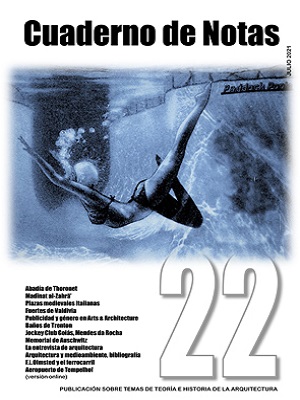A vueltas con la función y de vuelta a la forma : apuntes críticos en torno a la Casa de Baños de Trenton = Around function and back to form : A critical inquiry into the Trenton Bath House
DOI:
https://doi.org/10.20868/cn.2021.4749Palabras clave:
Revisión moderna, orden modular, forma y función, Louis I. Kahn, Anne Tyng, revision of the modern movement, modular order, form and functionResumen
Resumen
Durante los años cincuenta, en su búsqueda de alternativas a la planta libre, Kahn sentó las bases de una auténtica (contra)revolución espacial, fundada en el reconocimiento de la estancia como entidad arquitectónica de carácter primigenio. Tras los ensayos teóricos de las Casas Adler y DeVore, el pabellón de Baños de Trenton materializa de manera ejemplar el proceso de emancipación de la forma arquitectónica propuesto por Kahn en esos años, desde la experimentación consciente con mecanismos geométricos repetitivos. El presente artículo aborda esta cuestión desde dos perspectivas entrelazadas: por un lado, tomando el concepto de emancipación como sinónimo de autonomía física, perceptiva y simbólica de la estancia, basada en un renovado compromiso entre envolvente y estructura. Y por otro, como sinónimo de independencia entre espacio y función, una lección extraída del pasado que Kahn supo manipular y adaptar al presente, en un momento clave de su carrera fuertemente influenciado por Anne Tyng.
Abstract
During the 1950s, in his search for alternatives to the open plan, Kahn laid the foundations for a real spatial (counter)revolution, founded on the recognition of the room as a primary architectural entity. After the theoretical projects for the Adler and DeVore Houses, the Trenton Bath House was materialized as an illustrating example of the emancipation process of the architectural form proposed by Kahn in those years, based on a conscious experimentation with geometrical patterns. This article addresses this issue from two intertwined perspectives. On the one hand, it takes the concept of emancipation as synonymous with the physical, perceptual and symbolic autonomy of the room, based on a renewed allegiance between enclosure and structure. On the other hand, it understands emancipation as synonymous with independence between space and function, a lesson that Kahn drew from the past and that he was able to reshape and adapt to the present, in a key moment of his career strongly influenced by Anne Tyng.
Descargas
Referencias
Brownlee David B. y De Long, David G. 1991. Louis I. Kahn: in the Realm of Architecture: [exhibition]. Nueva York: Rizzoli.
Cortés, Juan Antonio, 2013. Historia de la retícula en el siglo XX. De la estructura domino a los comienzos de los años setenta. Valladolid: UVA.
Eisenman, Peter, 2011. Diez edificios canónicos 1950- 2000. Barcelona: Gustavo Gili [1a ed. en inglés, 2008]
Forty, Adrian, 2000. Words and buildings: a vocabulary of modern architecture. Londres: Thames & Hudson.
Frampton, Kenneth, 1980. Louis Kahn and the French connection. Oppositions 22: 21–53.
Gast, Klaus Peter, 1998. Louis I. Kahn: the Idea of Order. Basel: Birkhäuser.
Gast, Klaus Peter, 1999. Louis I. Kahn. Basel: Birkhäuser.
Hertzberger, Herman, 1962. Flexibility and Polyvalency. Forum 3: 115-118.
Hill, Jonathan, 2003. Actions of Architecture: Architects and Creative Users. Londres: Routledge.
Huff, William, 1981. Sorted Recollections and Lapses in Familiarities, Little Journal Society of Ar-chitectural Historians 5 (septiembre).
Kahn, Louis I. 1955. Order and Form, Perspecta, 3: 46–59.
Kahn, Louis I. 1957. Order in Architecture, Perspecta, 4: 58–63.
Kahn, Louis I. y Tyng, Anne, 1997. The Rome Letters 1953-1954. Nueva York: Rizzoli.
Kahn, Louis I., 2003. Talk at the conclusion of the Otterlo Congress (1959). En: Robert Thombly (ed.), Louis Kahn. Essential Texts. Nueva York, Londres: W. W Norton & Co. 37–61.
Koolhaas, Rem y Mau, Bruce, 1995. SMLXL. The Monacelli Press: Nueva York.
Lucan, Jacques, 1994. De Guadet a Kahn: el tema de la sala. En: Sabini, M. (ed.), Louis I. Kahn. Barcelona: Serbal. 93-102.
Marchard, Bruno. 2006. La nature organique des formes de la croissance. Le cas particulier des structures nappes horizontales. Matières 8: 20–34.
Martín, Guiomar y Rodríguez, Isabel. 2018. Diálogos cruzados entre Louis I. Kahn, Anne Tyng y Colin Rowe. ZARCH Journal of interdisciplinary studies in Architecture and Urbanism 11: 139- 153.
Merrill, Michael, 2010. Louis Kahn: on the Thoughtful Making of Spaces: the Dominican Motherhouse and a Modern Culture of Space. Baden: Lars Müller Publishers.
Moneo, Rafael, 1985. La vida de los edificios. Las ampliaciones de la Mezquita de Córdoba. Arquitectura (Madrid) 256: 26–36.
Rivalta, Luca, 2003. Louis I. Kahn: la construction poétique de l’espace. Paris: Le Moniteur.
Ronner, Heinz, y Jhaveri. Sharad, 1987. Louis I. Kahn: Complete Work 1935-1974. Basilea: Birkhauser.
Scully, Vincent (ed.), 1987. The Louis I. Kahn Archive: Personal Drawings, University of Pennsylvania and Pennsylvania Historical and Museum Commission. Garland Architectural Archives. Nueva York: Garland Publishing.
Solomon, Susan G., 2000. Louis I. Kahn’s Trenton Jewish Community Center. Nueva York: Princeton Architectural Press.
Wurman, Richard S. (ed.), 1990. What Will Be Has Always Been: the Words of Louis I. Kahn. Nueva York: Acces and Rizzoli
Wright, Frank Lloyd, 1992. In the Cause of Architecture: Composition as Method in Creation (escrito en 1928). En: Brooks Pfeiffer, B. (ed.) Frank Lloyd Wright Collected Writings. Nueva York: Rizzoli.
Van Eyck, Aldo, 2008. The Child, the City and the Artist, (escrito en 1962). Amsterdam: SUN.
Venturi, Robert. 1972. Complejidad y contradicción en la arquitectura, Barcelona: Gustavo Gili.
Ref. web.1: http://www.arthistory.upenn.edu/themakingofaroom/













